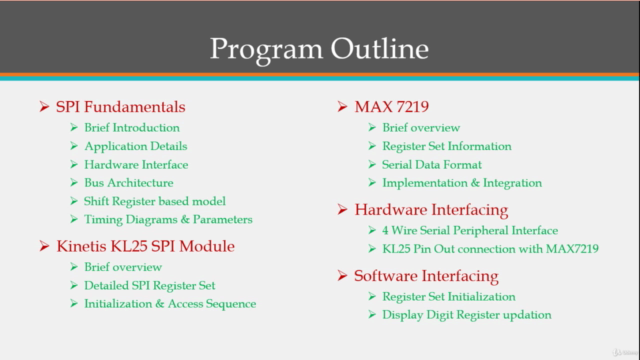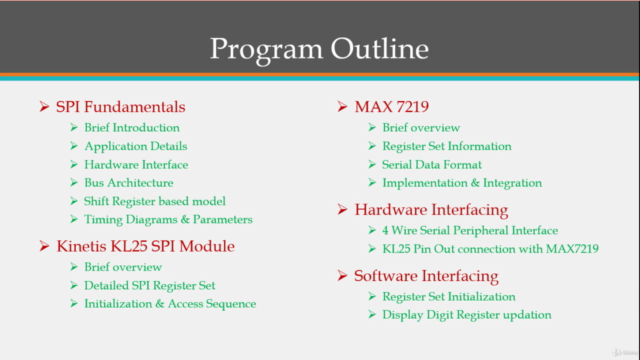Serial Peripheral Interface - NXP Kinetis KL25, MAX7219

Why take this course?
🎓 Mastering SPI Communications with NXP Kinetis KL25 & MAX7219: Unleash Your Device's Potential!
🚀 Course Title: Serial Peripheral Interface - NXP Kinetis KL25, MAX7219
👨💻 Instructor: Hariharan Veerappan
📘 Course Description:
Dive into the fascinating world of SPI (Serial Peripheral Interface) and learn to harness the full potential of the NXP Kinetis KL25 microcontroller, coupled with the versatile MAX7219 8-digit LED display controller. This comprehensive course will not only provide you with a solid theoretical foundation but also equip you with practical skills through hands-on projects and detailed examples.
Key Topics Covered:
-
Understanding SPI Fundamentals: Get to grips with the basics of SPI communication, its advantages over other interfaces, and how it fits into embedded systems.
-
Kinetis KL25 SPI Module: Delve deep into the SPI module of the Kinetis KL25 microcontroller, exploring its register set, initialization sequence, and configuration options.
-
MAX7219 Explained: Uncover the intricacies of the MAX7219 LED display controller, learning how to control up to 8 digits with ease.
-
Practical Hardware Implementation: Follow step-by-step instructions to wire your KL25 and MAX7219 correctly, ensuring a solid foundation for SPI communication.
-
Software Mastery: Write effective software to initialize the devices, handle data transfer, and manage the display updates in real-time.
Course Highlights:
-
Hands-On Learning: Engage with practical exercises that reinforce your understanding of SPI and MAX7219 interfacing.
-
Real-World Demo Program: Work through a complete demo program that showcases the SPI communication between the KL25 and MAX7219 to display data on an 8-digit LED display.
-
Detailed Register Analysis: Examine the register settings for both the KL25 SPI module and the MAX7219 to optimize performance and functionality.
-
Hardware Pin Interfacing: Learn about the specific hardware pin configuration required for interfacing, including PTD0 (SS), PTD1 (SCK), PTD2 (MOSI), and PTD3 (MISO) with the KL25 microcontroller.
By the end of this course, you will be equipped with the knowledge and skills to confidently interface SPI devices like the MAX7219 with the NXP Kinetis KL25 microcontroller, paving the way for your next innovative project or product!
👨🔧 Who Should Take This Course?
- Embedded Systems Engineers
- Hobbyists and Makers working on DIY projects
- Electronics Enthusiasts aiming to learn more about SPI communications
- Developers looking to expand their expertise with microcontrollers
🛠️ What You Will Need:
- NXP Kinetis KL25 Microcontroller Development Board
- MAX7219 8-digit LED Display Controller Module
- Basic understanding of C programming and embedded systems
- Soldering Iron and Breadboard (for practical exercises)
🌟 Take the Next Step in Your Embedded Systems Journey! Enroll in this course to become an expert in interfacing SPI devices and transform your projects with state-of-the-art LED displays. Let's embark on this learning adventure together! 🚀💡
Course Gallery




Loading charts...